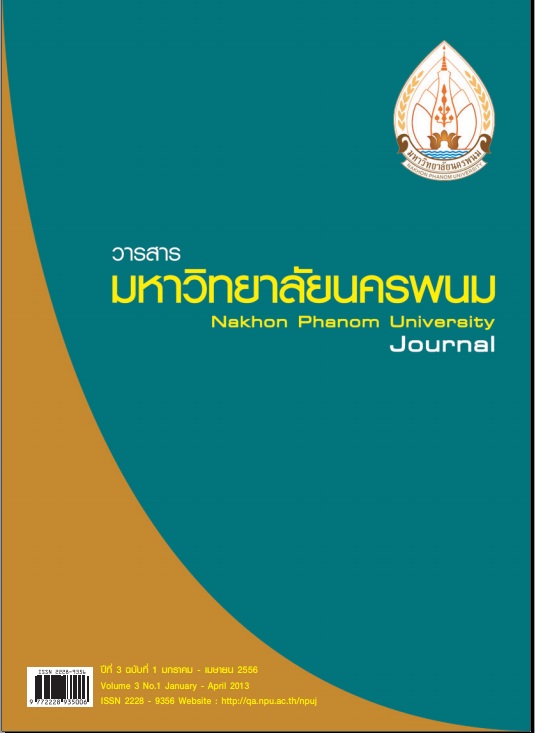การเปรียบเทียบผลสัมฤทธิ์ทางการเรียนวิชาคณิตศาสตร์ เรื่อง “ระบบจำนวนเต็ม” และความสามารถในการคิดวิเคราะห์ ของนักเรียนชั้นมัธยมศึกษาปีที่ 1
Main Article Content
Abstract
การวิจัยครั้งนี้มีวัตถุประสงค์เพื่อ 1) เปรียบเทียบผลสัมฤทธิ์และความสามารถในการคิดวิเคราะห์ระหว่างการเรียนรู้ด้วยกิจกรรมการเรียนรู้แบบกลุ่ม TAI และกิจกรรมการเรียนรู้แบบ 4 MAT และ 2) ศึกษาความพึงพอใจต่อกิจกรรมการเรียนรู้แบบกลุ่ม TAI และกิจกรรมการเรียนรู้แบบ 4 MAT ประชากรเป็นนักเรียนชั้นมัธยมศึกษาปีที่ 1 ภาคเรียนที่ 1 ปีการศึกษา 2554 โรงเรียนธารน้ำใจและโรงเรียนไทยรัฐวิทยา 50 (บ้านคำพี้) อำเภอนาแก จังหวัดนครพนม จำนวน 4 ห้อง รวม 119 คน กลุ่มตัวอย่างที่ใช้ในการวิจัยเป็นนักเรียนชั้นมัธยมศึกษาปีที่ 1 โรงเรียนธารน้ำใจ จำนวน 59 คน จาก 2 ห้อง เป็นกลุ่มทดลองที่ 1 จำนวน 29 คน จัดกิจกรรมการเรียนรู้แบบกลุ่ม TAI และกลุ่มทดลองที่ 2 จำนวน 30 คน จัดกิจกรรมการเรียนรู้แบบ 4 MAT ซึ่งได้มาโดยการเลือกแบบเจาะจง แล้วสุ่มอย่างง่าย โดยการจับสลากเพื่อเลือกห้องสำหรับการทดลอง เครื่องมือที่ใช้ ในการวิจัย ได้แก่ แบบวัดผลสัมฤทธิ์ทางการเรียนชนิดเลือกตอบ 4 ตัวเลือก จำนวน 40 ข้อ มีค่าความยากตั้งแต่ 0.49 ถึง 0.80 ค่าอำนาจจำแนกตั้งแต่ 0.22 ถึง 0.80 และค่าความเชื่อมั่นเท่ากับ 0.96 แบบวัดความสามารถในการคิดวิเคราะห์ จำนวน 20 ข้อ มีค่าความยากตั้งแต่ 0.36 ถึง 0.78 ค่าอำนาจจำแนกตั้งแต่ 0.22 ถึง 0.67 และค่าความเชื่อมั่นเท่ากับ 0.81 และแบบสอบถามความพึงพอใจในการเรียนที่มีต่อกิจกรรมการเรียนรู้แบบกลุ่ม TAI และกิจกรรม การเรียนรู้แบบ 4 MAT เป็นแบบมาตราส่วนประมาณค่า 5 ระดับ จำนวน 20 ข้อ มีค่าอำนาจจำแนกตั้งแต่ 0.42 ถึง 0.76 และ 0.36 ถึง 0.76 ค่าความเชื่อมั่นเท่ากับ 0.88 และ 0.86 ตามลำดับ สถิติที่ใช้ในการวิเคราะห์ข้อมูล ได้แก่ ร้อยละ ค่าเฉลี่ย ส่วนเบี่ยงเบน มาตรฐาน และ t–test (Independent Samples) ผลการวิจัยพบว่า 1) นักเรียนชั้นมัธยมศึกษาปีที่ 1 ที่เรียนรู้ด้วยกิจกรรมการเรียนรู้ แบบกลุ่ม TAI (x = 33.31, S.D. = 2.55) และกิจกรรมการเรียนรู้แบบ 4 MAT (x= 32.77, S.D. = 2.73) มีผลสัมฤทธิ์ทางการเรียนและความสามารถในการคิดวิเคราะห์ไม่แตกต่างกัน 2) นักเรียนที่เรียนด้วยกิจกรรมการเรียนรู้แบบกลุ่ม TAI และกิจกรรมการเรียนรู้แบบ 4 MAT ต่างมีความพึงพอใจต่อกิจกรรมการเรียนรู้อยู่ในระดับมากที่สุด (x = 32.77, S.D. = 2.73 และ x= 32.77, S.D. = 2.73)
The purposes of this study were to : 1) Compare mathematics achievement and analytical thinking ability of Matthayomsuksa 1 students between TAI and 4 MAT cooperative learning and 2) Examine satisfaction of the two approaches. The populations in the study were students from 4 classrooms of Matthayomsuksa 1 attending the first semester, academic year 2011, Tarnnamjai School and Thairat Vitthaya 50 (Ban Kumpee) School, Nakea, Nakhon Phanom. The sample used in this study consisted of students from 2 classrooms of Matthayomsuksa 1, 29 students in using 4MAT and 30 students in using TAI, attending Tarnnamjai School, selected by the purposive sampling technique. There were four types of instruments used in the study TAI cooperative and 4MAT learning activities plans, 12 plans each; 40-item mathematics achievement test with the difficulty ranging 0.49-0.80, the discrimination powers ranging 0.22-0.80, and the reliability (rcc ) of 0.96, 20-item analytical thinking ability test with the difficulty ranging .36-.78, the discrimination powers ranging 0.22-0.67, and the reliability (rcc) of 0.81, and 20-item of 5 scale questionnaire on student’s satisfaction toward 4 MAT and TAI cooperative, the discrimination power ranging 0.42- 0.76 and 0.36-0.76, and the reliability of 0.88 and 0.86 respectively. The statistics used for data analyzing were percentage, mean, standard deviation, and the independent samples t-test for testing hypothesis. The results of the study were 1) The efficiencies of learning activity plans in mathematics entitled “NUMBER SYSTEM” for Matthayomsuksa 1 using TAI approach (x = 33.31, S.D. = 2.55) and 4 MAT approach(x = 32.77, S.D. = 2.73) did not show learning achievement and analytical thinking ability differently, and 2) The students learning TAI and 4 MAT were satisfied in both of learning activities at the high level (x = 32.77,
S.D. = 2.73 and x = 32.77, S.D. = 2.73 respectively.)


